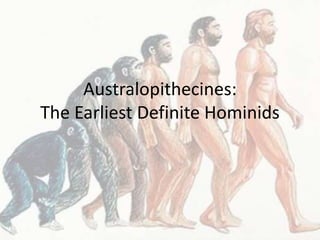
The Australopithecines- Anthropology
- 1. Australopithecines: The Earliest Definite Hominids
- 2. Origins and Classifications • In the mainland of Africa, discoveries of fossils are the work of the paleoanthropologists just to trace the origins of man. • Ethiopia, Tanzania, and Kenya- were the places of particular excavations and believed that man or bipedal hominids lived and walked there between 4 -3 million years ago. • At Laetoli, Tanzania, more than 50 hardened humanlike footprints from about 3.6 million years old.
- 3. Origins and Classifications • Excavated evidences in Africa were classified as Australopithecines. • Paleoanthropologists divided the genus australopithecus into four species. – Australopithecus anamensis – Australopithecus afarensis – Australopithecus africanus – Australopithecus boisei – Australopithecus robustus
- 7. Australopithecus Anamensis • Discovered at the east of Lake Turkana, Kenya • Believed to be 4.2 million years
- 9. Australopithecus Afarensis • Found in the east of Africa from 4 to 3 million years ago. • It was depicted that the fossils of these species are clear bipeds and thus originated from Laetoli, Hadar, and Ethiopia. • Paleoanthropologist based their classification through the appearances of their teeth, jaws, and skull are still more alike to apes. • Believed to be the fore species of the A. africanus.
- 13. Australopithecus Africanus • Lived between 3 to 2 million years ago. • Excavated at the caves at Sterkfontein and Makapansgat in South Africa. • The braincase is rounded with relatively well- developed forehead. • It was also believed that the Taung Child by Dr. Raymond Dart was so similar with this type of specie.
- 17. Australopithecus boisei and robustus • Robustus lived in East Africa and in South Africa about 2.5 to 1 million years ago. • Classified too as paranthropus which means beside humans. • Believed to be resided at the caves in Kromdraai and in Swartkrans, and later in the Omo basin in Ethiopia, lake in Turkana Kenya and in Olduvai Gorge in Tanzania.
- 18. Australopithecus boisei and robustus • Boisei was believed to walked around 2.5 million years ago. • Paleoanthropologist refer boisei as descendants from the robustus and the africanus and thus, named as Australopithecus aethiopicus. • Characterized as having extreme features with large molars, thick and deep jaws, thick cheek bones
- 23. Early Species : HOMO • They are hominids that are absolutely and relatively larger than that of the australopithecines appear about 2.5 million years ago. • Classified in our own specie, homo, discovered in Olduvai Gorge by Louis Leakey, Phillip Tobias, and John Napier.
- 24. HOMO HABILIS • Classified as the first specie of the homo genus. • Apparently lived in the same place together with the robustus and boisei. • They do have large brains and reduced molars and premolars.
- 27. Homo Erectus • They were found first in Java, China ,and Africa. • It was believed that they moved and lived in Eastern Africa round 1.6 million years ago and about 1 million years ago in Asia. • Recent re-dating suggest that early discoveries of H. erectus in Java maybe somewhat older dating to perhaps 1.8 million years ago.
- 30. Homo Sapiens • Scientist believed that the H. Erectus evolved to Homo Sapiens. • Early fossils of the discoveries of the Homo Sapiens were found in Africa, Europe and Asia. • Particular in Broken Hill mine in Zambia dating from 200,000 years ago. • Its cranial capacity is 1200 cc. • Low forehead, large brow ridges. • Closely related to the Neandertals who were considered also as the modern human beings classified as Homo Sapiens Neandertalensis.
- 31. Early Hominid Cultures • Tool Traditions (2.5 million years) • Percussion flaking – Striking stone with another stone • Unifacial tools • Bifacial tools
- 32. Life style • Archaeologists believed that early hominids in Olduvai Gorge had already specific lifestyles. • They were very particular with their stone tools. • Tools were studied and analyzed, and then believed to be used for whittling wood into sharp-pointed sticks, dismembering animals, and slitting the hides of some animals.
- 33. Early Hominid Cultures • H. erectus used stone tools, known as Acheulian tool that was formed and discovered as stone-like hammers. • Big –Game Eating • Control of Fire • Campsites